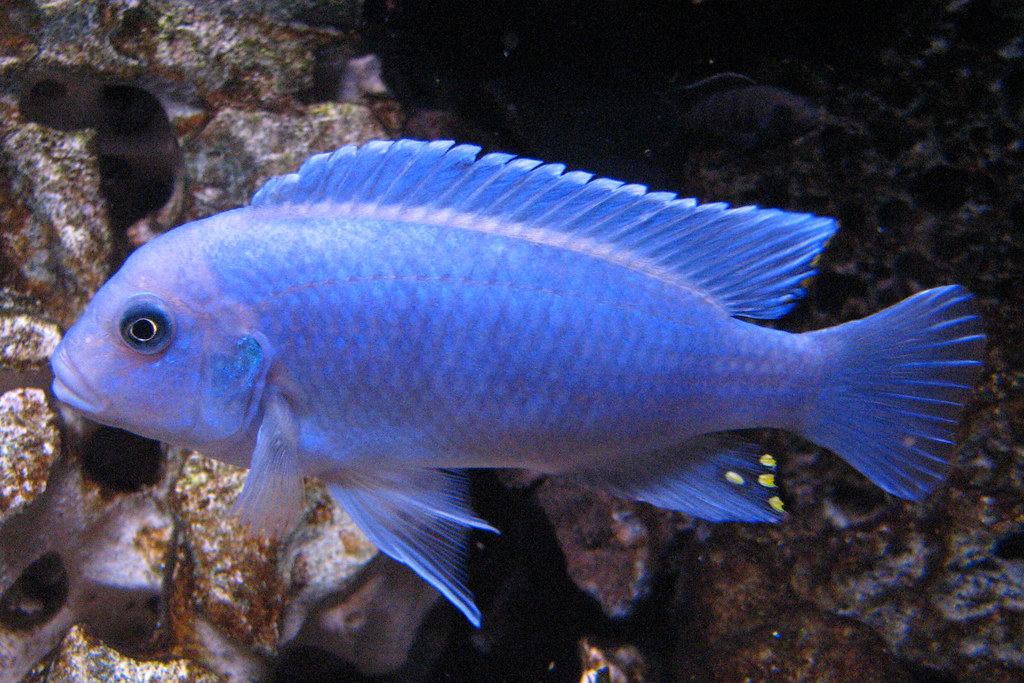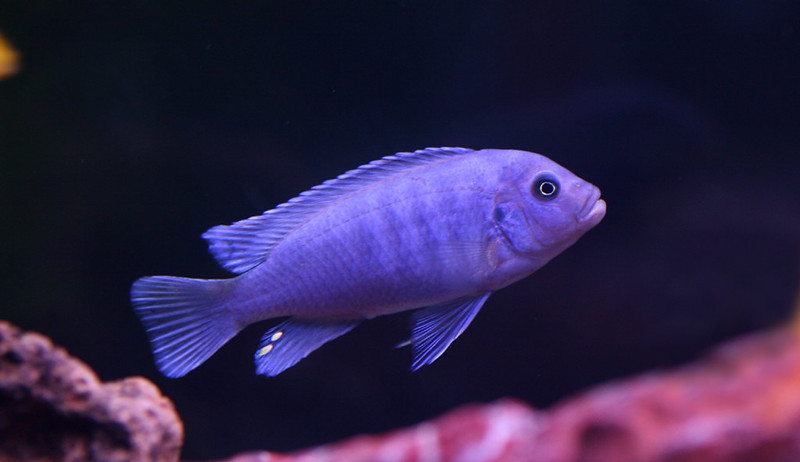Cobalt Zebra Cichlid
The Cobalt Zebra Cichlid, Metriaclima callainos, is a charismatic freshwater specie hailing from Lake Malawi, one of the grandiose Rift lakes in Africa.
This Cichlid holds a distinction of being one of the earliest African fishes to be imported for the purpose of fish husbandry.
- Experience Level: Intermediate
- Hardiness: Hardy
- Minimum Tank Size: 75 gal (285 L)
- Maximum Size: 5 inches (13 cm)
- Temperament: Semi Aggressive
- Temperature: 77 – 82° F (25 – 28° C)
- pH Range: 7.5 – 8.5
- Water Hardness: 7 – 20 dGH
- Diet: Omnivore
Table of Contents
Introduction
Size and Appearance
Care Guide
Tank Mates
Diet and Feeding
Breeding
A type of cichlid specifically branded as Mbuna or rock-dwelling, Cobalt Zebra Cichlids gravitate towards rocky aquariums with scant vegetation, indicative of their natural habitat in the deeper rocky waters of the East African Lake Malawi.
Their natural homes are predominantly situated in the caverns and small caves which are formed as a result of large rocks scrambled together amidst rocky islands or sand-surrounded rocky promontories. The cichlid here are mostly solitary beings using their robust jaws for feeding on algae, insects or crustaceans.
Size and Appearance
The Cobalt Zebras appearance can vary with males typically embracing a vibrant blue shade in their natural habitat in Lake Malawi. However, in the United States, selective breeding has led to the emergence of males showcasing a distinctly radiant orange and red shade, earning them titles such as the Orange Zebra Cichlid, Orange African Cichlid, or simply, the Orange Cichlid fish. Both male and female species can shift into vivid blues, yellows, and reds or carry the blue-on-blue stripe pattern that gives the species its identifiable name, an interesting phenomenon known as polychromatism.
The males flaunt four orange egg spots on the softer, rays-replete part of their anal fin which turn relevant at mating season. They also bear less distinct spots on the rear edge of their dorsal fin. Males generally display larger sizes, richer colors, and a more aggressive stance than the more muted females with rounder body shapes. Both sport fins close to the body and are powerful swimmers. With the right care and maintenance, the Zebra Cichlid’s lifespan can extend up to a decade.
Care Guide
- Minimum Tank Size: 75 gal (285 L)
- pH Range: 7.5 – 8.5
- Water Hardness: 7 – 20 dGH
- Temperature: 77 – 82° F (25 – 28° C)
- Lighting: Moderate, diffused lighting
- Substrate: Fine sand/gravel
- Brackish: No
- Water Flow: Low to moderate
- Tank Region: All areas
The tank should ideally have a gravel base topped with larger rocks configured to make caves, recreating its rocky habitat in Lake Malawi. Multiple Cobalt Zebras require a smart arrangement of rocks and caverns to curtail line of sight, and consequently, aggression. Make sure to size the caverns keeping in mind the mature Zebra Cichlid size of up to 8 inches to avoid constant rearrangements.
Plants and driftwood usually don’t fare well in a Zebra Cichlid tank due to their propensity to uproot vegetation and disturb the water pH levels, respectively. The Zebras aquarium water should be clean, hard freshwater, possibly achieved with double the standard filtration of similar size tanks along with water movement for adequate oxygenation. Also, the use of underground filters should be avoided owing to the Zebra Cichlid’s digging habits and it is advised to try and keep most of the filtration system outside the tank. Addition of crushed coral to the gravel can help maintain the ideal pH range for a Zebra Cichlid aquarium, which is between 7.5 to 8.5.
Tank Mates
It can be a tough task to control aggression in Zebra Cichlids calling for a strategic selection of tank mates. Turning to similarly rock-oriented Mbuna cichlids like Auratus, Johanni, Kenyi, and Pindani can mitigate conflicts, especially if their coloring stands markedly distinct from the Zebra Cichlid. This approach works well if you wish to keep more than a single male in the tank. As an alternative, Synodontis Catfish can co-exist peacefully but the likes of Haplochromis or Peacock Cichlids are a definite mismatch considering Zebra Cichlids’ aggression.
Feeding Guide
- Diet: Omnivore
- Frequency: Several small feedings per day
- Pellet Foods: Yes
- Flake Foods: Yes
- Live Foods: Yes
- Meat Foods: Yes
- Vegetable Foods: Yes
Being a herbivores specie, Cobtalt Zebra Cichlids thrive on a plant-based diet. Excessive animal protein can serious health issues including bloating or even lead to fatal consequences. For a well-rounded diet, sinking, palletized food designed for herbivore cichlids can be supplemented with small chunks of lettuce, spinach, zucchini, or squash. Multiple small servings each day can be preferred option to keep tank aggression at bay.
Breeding
Breeding Cobalt Zebra Cichlids in captivity brings much joy to aquarists. It becomes tricky given that we cannot ensure fertility, and moreover, hybrid species created by many keepers and commercial houses may render the fish sterile. If you wish to breed Zebra Cichlids, you must buy from a guaranteed source of fertility.
Zebra Cichlids do not bond for life, hence trying to establish breeding pairs is a futile attempt. A male to female ratio of 1:4 or more is recommended for successful breeding. Courtside occurrences such as jaw locking, nipping, fin displays, and chasing, which may often be mistaken as aggression, usually mark the onset of breeding.
Cobtalt Zebras breed in the mouthbrooding style such that eggs are incubated in the mother’s mouth. The mother retrieves the eggs as they drop while the male stays nearby. Typical egg clutches vary between 10 to 50 eggs. Following the laying, the male releases sperm to fertilize the eggs held in the female’s mouth, disguised near his egg-shaped and colored spots near the anal fin.
Upon the completion of spawning, the male expels the female who then swims freely until the eggs hatch after 10 to 15 days and she releases the fry. Moving a female carrying the eggs to an alternative tank is strongly discouraged since the associated stress could result in the death of the eggs.



